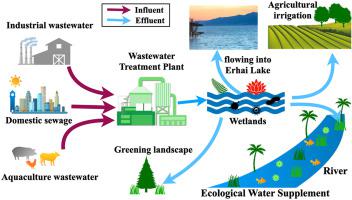Journal of Cleaner Production ( IF 11.1 ) Pub Date : 2021-10-25 , DOI: 10.1016/j.jclepro.2021.129435 Yang Fengle 1, 2 , Zhang Xianzhi 2 , Li Jinhua 1 , Zhao Hongfeng 1 , Jin Fangming 1 , Baoxue Zhou 1, 3

|
The utilization of reclaimed water is an important way to solve the shortage of water resources. Here, an analysis and evaluation of the tailwater treatment and reuse from 6 wastewater treatment plants (WWTPs) located in suburb surrounding the Erhai Lake after the completion of representative project on sewage interception and pollution control was conducted. All tailwater was deeply treated by wetland and pond, which was used for agricultural irrigation, greening landscape and ecological supplement water of water-scarce rivers. The reclaimed water used inside and outside the Erhai Basin is 25432.3 m3/d and 18181.1 m3/d which accounts for 58.3% and 41.7% of the total tailwater, respectively. The implementation of the project has remarkably diminished pollution loads before it enters the Erhai Lake, and about 83.3% of chemical oxygen demand (COD), 90.8% of total nitrogen (TN), and 78.8% of total phosphorus (TP) loads has been reduced. Based on the analysis, the characteristic index system including 13 indicators was constructed from three aspects of environmental benefit, social-economic benefit and consumption-resource benefit and the analytic hierarchy process (AHP) was applied to determine the weight. According to the above evaluation results, it can conclude that the environmental benefit, social-economic benefit and consumption-resource benefit of the reclaimed water reuse project are significant. Especially for social-economic benefit, the three indicators all belonged to the first and second class. It suggested that the ecological purification and reclaimed water use project has effectively reduced the nitrogen and phosphorus pollutants, and alleviate the problem of water shortage in the water-scarce plateau area. The results of the paper are expected to provide a scientific basis and practical engineering guidance for the deep treatment and resource utilization of tailwater.
中文翻译:

尾水处理回用分析与评价——以洱海为例
再生水的利用是解决水资源短缺的重要途径。在此,对环渤海近郊6座污水处理厂(WWTPs)尾水处理回用情况进行了分析评价。尾水全部经过湿地和池塘深度处理,用于农业灌溉、绿化景观和缺水河流的生态补水。洱海流域内外中水使用量为25432.3 m 3 /d和18181.1 m 3/d 分别占尾水总量的 58.3% 和 41.7%。项目实施后,入洱海前污染负荷显着减少,化学需氧量(COD)约83.3%、总氮(TN)约90.8%、磷(TP)总负荷约78.8%。减少。在分析的基础上,从环境效益、社会经济效益和消费资源效益三个方面构建了包括13个指标的特征指标体系,并应用层次分析法(AHP)确定权重。根据以上评价结果,可以得出中水回用工程的环境效益、社会经济效益和消耗资源效益显着。特别是为了社会经济效益,三项指标均属于第一类和第二类。表明生态净化和再生水利用工程有效减少了氮磷污染物,缓解了高原缺水地区的缺水问题。论文结果有望为尾水深度处理和资源化利用提供科学依据和实际工程指导。

























 京公网安备 11010802027423号
京公网安备 11010802027423号